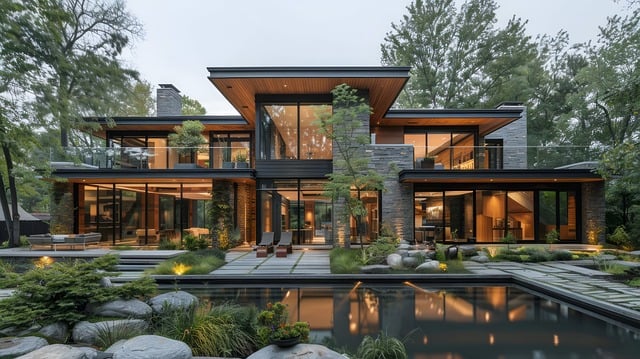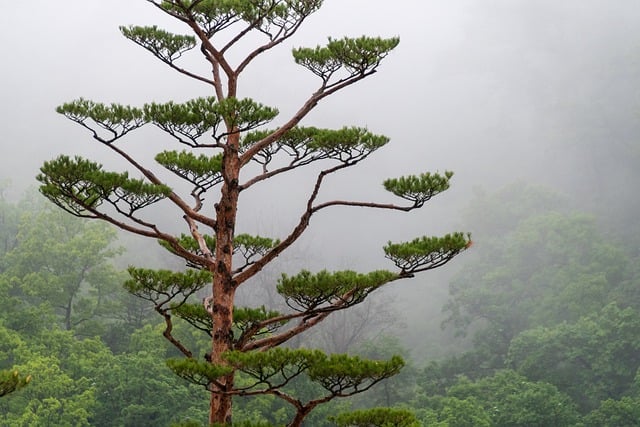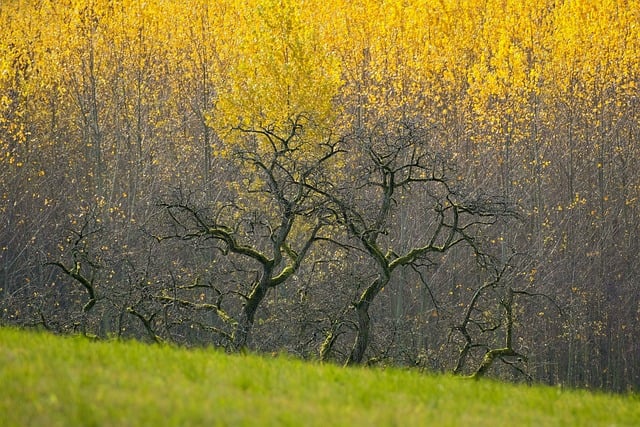When designing a pet-friendly outdoor space, prioritize safety by selecting non-toxic plants and incorporating secure elements like safe fencing. Choose local climate and soil-suitable plants that are known to be safe for pets, such as marigolds, zinnias, and sunflowers. Include landscaping features that provide shade, enclosure, and diversity in textures and scents, and consider pet-safe alternatives like artificial turf for maintenance simplicity. Ensure proper drainage with permeable pavements or rain gardens to maintain a healthy environment for pets, especially during wet weather. Designate interactive spaces such as obstacle courses and sandboxes for pet entertainment. Integrate water features with shallow pools for pets to safely enjoy. Use durable materials for landscaping to minimize messes and protect natural areas. With these considerations, you can create a beautiful, secure, and functional pet-friendly landscape that enhances your home's environment and provides a delightful retreat for your pets.
When integrating landscaping elements into your yard, prioritizing pet safety becomes paramount. This article navigates through essential strategies for creating a pet-friendly outdoor haven. From selecting non-toxic plants to designing secure enclosures, we explore how to landscape your space with both aesthetics and animal well-being in mind. We’ll delve into innovative drainage solutions that enhance comfort across all weather conditions and offer ideas for interactive features that encourage a healthy bond between pets and their surroundings. Join us as we transform your yard into a safe, engaging, and harmonious environment for your beloved companions.
- Assessing Your Pet-Friendly Landscape Needs: Understanding the Dos and Don'ts of Pet-Safe Plant Selection
- Creating a Safe Outdoor Space: Fencing, Shade Structures, and Enclosed Areas for Comfort and Security
- Pet-Proof Plants and Materials: Incorporating Non-Toxic Landscaping Elements into Your Yard Design
- Innovative Drainage Solutions to Keep Your Pets Safe and Comfortable in All Weathers
- Integrating Interactive Features: Pet-Friendly Garden Activities and Play Areas for a Harmonious Coexistence with Nature
Assessing Your Pet-Friendly Landscape Needs: Understanding the Dos and Don'ts of Pet-Safe Plant Selection

When curating a pet-friendly landscape, it’s crucial to select plants that are non-toxic to animals. Start by assessing your yard for any existing vegetation that may pose a risk to your pets. Remove or replace these with pet-safe alternatives from your local nursery or garden center. Consider the landscaping elements that provide both aesthetic appeal and safety for your furry friends, such as fencing off certain areas or incorporating a variety of textures and scents that are benign. Opt for plants known to be safe for pets, ensuring they can thrive in your region’s climate and soil conditions. Regular maintenance is key; keep grass trimmed to prevent ticks and fleas from inhabiting your yard, and regularly inspect your pet after outdoor play for any foreign objects or plant material that may cause harm. By thoughtfully selecting your landscaping elements with your pet’s safety in mind, you can create a harmonious and secure outdoor environment for them to enjoy.
Creating a Safe Outdoor Space: Fencing, Shade Structures, and Enclosed Areas for Comfort and Security

When designing a safe outdoor space for pets, prioritizing their comfort and security is paramount. Landscaping elements that offer both shade and enclosure can significantly enhance your pet’s well-being. Fencing plays a crucial role in keeping your pet within a defined boundary, protecting them from wandering off or encountering hazardous situations. Opt for fence designs that are both sturdy and aesthetically pleasing, ensuring they blend seamlessly with the garden landscape. Incorporating shade structures like pergolas or gazebos not only protects your pet from harsh weather conditions but also creates a comfortable retreat where they can relax or seek shelter during outdoor activities. Strategic placement of these structures within the yard’s landscaping can provide both respite from the elements and an engaging environment for your pet to explore. Additionally, consider installing artificial turf in your pet’s play area; it’s a low-maintenance solution that eliminates the need for chemicals often found in real grass, keeping your pet safe from potential toxins. By thoughtfully integrating these landscaping features, you can create an outdoor sanctuary that offers your furry companion a secure and enjoyable environment to roam.
Pet-Proof Plants and Materials: Incorporating Non-Toxic Landscaping Elements into Your Yard Design

Creating a safe and inviting outdoor space for both you and your pets necessitates careful consideration of your landscape design. Opting for non-toxic plants is paramount to ensure pet safety; many common garden plants can be hazardous to pets if ingested. When selecting plant species for your yard, prioritize those known for their pet-friendly characteristics. For instance, marigolds, zinnias, and sunflowers are vibrant choices that add color without posing a risk to curious noses and paws. Additionally, incorporating landscaping elements such as natural stone paths or gravel areas can provide safe alternatives to wood chips or mulches that might be harmful if ingested by pets. These materials not only enhance the aesthetic appeal of your landscape but also contribute to a safer environment for your furry companions.
Investing in pet-safe landscaping is a commitment to the well-being of your animals and can prevent costly veterinary visits due to plant poisoning. Each element of your yard design, from the plants to the hardscaping, should be carefully selected with your pets’ safety in mind. Utilize resources like the ASPCA’s list of toxic and non-toxic plants to guide your choices. By prioritizing pet-safe landscaping, you can create a thriving outdoor space that both you and your pets can enjoy with peace of mind. Remember to consider the layout of your yard to ensure there are clear sightlines and open spaces for your pets to play and explore without encountering any harmful materials.
Innovative Drainage Solutions to Keep Your Pets Safe and Comfortable in All Weathers

When designing your outdoor space with both aesthetics and pet safety in mind, innovative drainage solutions are a crucial aspect of landscaping to consider. Proper drainage not only prevents waterlogging that can harbor diseases but also ensures that your pets have a comfortable yard regardless of the weather. For instance, integrating a permeable pavement system can allow rainwater to seep through, reducing flooding and maintaining a safe, dry environment for your pets to roam. Additionally, incorporating dry creek beds or swales into your landscape design can manage surface runoff effectively while adding an attractive, natural feature to your yard. These features also encourage pet-friendly play areas that are both functional and visually appealing, providing a harmonious balance between form and function in your pet’s outdoor experience.
In climates prone to heavy rains or snowmelt, landscape solutions such as rain gardens can be particularly beneficial. These gardens are strategically designed to capture runoff, allowing water to soak into the ground rather than creating puddles that pets may trample into muddy messes. The variety of plants in a rain garden can also create an absorptive medium, further enhancing the landscape’s ability to manage water while offering a dynamic and colorful environment for your pets to explore. By prioritizing effective drainage within your pet-friendly yard, you ensure that your furry companions remain safe and comfortable, come sun or rain.
Integrating Interactive Features: Pet-Friendly Garden Activities and Play Areas for a Harmonious Coexistence with Nature

Creating a pet-friendly garden that encourages interactive features and activities can foster a harmonious coexistence with nature. Landscaping with pet safety in mind involves selecting non-toxic plants and designing open spaces that allow for safe play. Interactive elements such as pet-safe obstacle courses, digging areas with sandboxes, or water features with shallow pools can provide mental stimulation and physical exercise for pets while they enjoy the outdoors. These landscaping choices not only enhance the pet’s experience but also complement the natural aesthetic of the garden, promoting a shared appreciation for the landscape.
Incorporating pet-friendly garden activities and play areas is essential for ensuring your furry friends remain entertained and safe. Landscaping with durable materials like synthetic turf for pets to run on can minimize messes and reduce wear on natural grass. Additionally, strategically placed landscaping elements such as hedges or fencing can create safe boundaries while maintaining the garden’s visual appeal. Thoughtful planning in the landscaping design can yield a backyard oasis that is both an extension of your home and a sanctuary for your pets.
In conclusion, crafting a safe and enjoyable outdoor space for pets requires thoughtful landscape design and careful selection of pet-friendly plants and materials. By adhering to the dos and don’ts of pet-safe plant selection, homeowners can ensure their yards are both beautiful and secure. Fencing, shade structures, and enclosed areas provide comfort and security, while non-toxic landscaping elements safeguard pets against harmful substances. Innovative drainage solutions further enhance pet safety and comfort in all types of weather. Additionally, incorporating interactive features such as pet-friendly garden activities and play areas encourages a harmonious coexistence with nature. With these considerations in mind, homeowners can create a pet-centric landscape that balances aesthetics with practicality, promoting the well-being of their furry companions.
